

| Part III. | ODA DISBURSEMENTS IN FISCAL YEAR 2002 |
Japan is advancing concrete assistance in the environmental field
based on the “Environmental Conservation Initiative for Sustainable Development
(EcoISD).” Japan’s assistance disbursements in the environmental field
in fiscal year 2002 amounted to approximately ¥405.4 billion by the total
of grant aid, Japan’s ODA loans, technical cooperation and contributions
to multilateral organizations, and they were approximately 34.9% of total ODA
disbursements. As cooperation utilizing Grant Aid for the Global Environment,
which was established in fiscal year 2001, in fiscal year 2002 Japan carried
out 11 projects and disbursements for these projects amounted to approximately
¥4.6 billion (E/N basis). These projects included “The Project for
Afforestation for Conservation of Middle Stream of Huang He” in China and
“The Project for Supply of Equipment for Waste Management in Hanoi City”
in Viet Nam.
A. Efforts to Address Global Warming
Japan is transferring and disseminating technologies to address global warming
to developing countries and enhancing their capacity to address this issue from
scientific, social and institutional aspects. ODA in this field is implemented
based on the “Kyoto Initiative” *1 and in fiscal year 2002,
in fields related to addressing global warming, Japan carried out training of
approximately 1,700 people (JICA disbursements) through technical cooperation
including acceptance of trainees and dispatch of experts. Through loan aid,
Japan provided approximately ¥79.5 billion (E/N basis) to implement seven
projects related to addressing global warming applying the most concessional
loan terms (priority interest rates). One such project was the “Henan Atmospheric
Environmental Improvement Project” in China.
Subsequently the detailed rules on the implementation of the Kyoto Protocol
were stipulated at the Seventh Session of the Conference of the Parties to the
United Nations Framework Convention on Climate Change (COP7) held in November
2001. The Clean Development Mechanism (CDM)*2 contributes to reducing
greenhouse gasses and promotes sustainable development in developing countries.
It is an important mechanism for the achievement of Japan’s reduction target
for emission. In fiscal year 2002, Japan implemented measures to promote CDM,
including the establishment of the “Liaison Committee for Utilization of
Kyoto Mechanism” constituted from related government offices and ministries,
the establishment of procedures to approve programs such as CDM and the development
of Japan’s National Registry for greenhouse gas reduction credits. Japan
intends to comply with international rules and implement ODA projects as CDM
projects, on the premise of the agreement of recipient countries.
B. Pollution Control
Support for measures to control pollution and improve the living environment
(air pollution, water contamination, waste management, etc.) in urban areas,
mainly in the Asian countries that are continuing to achieve rapid economic
growth, is becoming a higher priority. Japan has accumulated a lot of experiences
and technologies in the process of addressing domestic pollution issues and
it is utilizing these experiences and technologies to provide cooperation to
address pollution issues in developing countries.
Specific efforts in this field include the promotion of cooperation between
countries by the “Acid Deposition Monitoring Network in East Asia,”
through formation of a common understanding and information exchange of the
acid rain issue in East Asia, the building of capacity to respond to environmental
pollution in developing countries through technical cooperation for the “Environmental
Center” which is the core of the environmental administration in six countries
including China, Mexico, etc., and other such measures. And Japan is providing
support for the building of a pollution control manager system through the “Green
Aid Plan (GAP)” inaugurated in 1992 and now targeted to seven Asian countries,
support for creating manuals for environmental protection, support for research
and development tailored to the unique technical and development issues of developing
countries, and so on. Looking at a specific example, Japan made model cases
of environmental improvement by providing practical advice, including on-site
guidance in factories, and held dialogues with the government of the recipient
country concerning plans for improvement, including the dissemination of the
results of the model cases. Furthermore, Japan has formulated and provided response
manuals through the project to support measures to address fixed sources of
air pollution in developing countries.
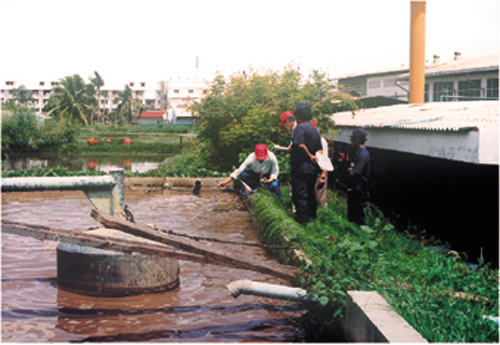 |
| Technical guidance at a previously-existing wastewater treatment plant under the auspices of the Green Aid Plan (Thailand). (Photo: the Water Re-Use Promotion Center) |
C. Fresh Water issues
In relation to environmental protection, Japan is implementing support for water
supply and sewage systems that take into account the characteristics of urban
and rural areas, and water resource management and water quality control. (Refer
for details.)
D. Conservation of Natural Environment
Japan is providing support to developing countries for nature reserves management,
forest-related issues, prevention of desertification, and natural resources
management, while taking into account the poverty reduction of the residents
in developing countries. Under the “National Strategy on Biological Diversity
of Japan” which was approved by Japan’s Council of Ministries for
Global Environment Conservation in March 2002, it is stated that because Japan
and the wider world, particularly the Asian region, have a deep relationship
both in terms of the natural environment and socio-economics, it is necessary
for Japan to actively contribute to the conservation of biodiversity in the
Asian region, etc.
Specific efforts in this field include enhancing and strengthening national
park management, improving the capacity of studies and research concerning conservation
of biodiversity, cooperation for the development of information systems under
the “Biodiversity Conservation Project” in Indonesia, and the holding
of meetings for the promotion of the “Asia Forest Partnership (AFP)”
*3 which was established to promote sustainable
forest management in Asia.
| Column 2 | International Cooperation Initiated by Japan—the Global Mapping Project | ||||
|
In response to the adoption of the action plan for sustainable
development “Agenda 21” at the 1992 United Nations Conference
on Environmental and Development (“Earth Summit”), in the
same year Japan proposed the “Global Mapping Project” initiative
in collaboration with the national cartography institutions of each
country and related international organizations. The initiative aims
at developing global geographical information to graph the current state
and changes of the global environment.
|
|||||
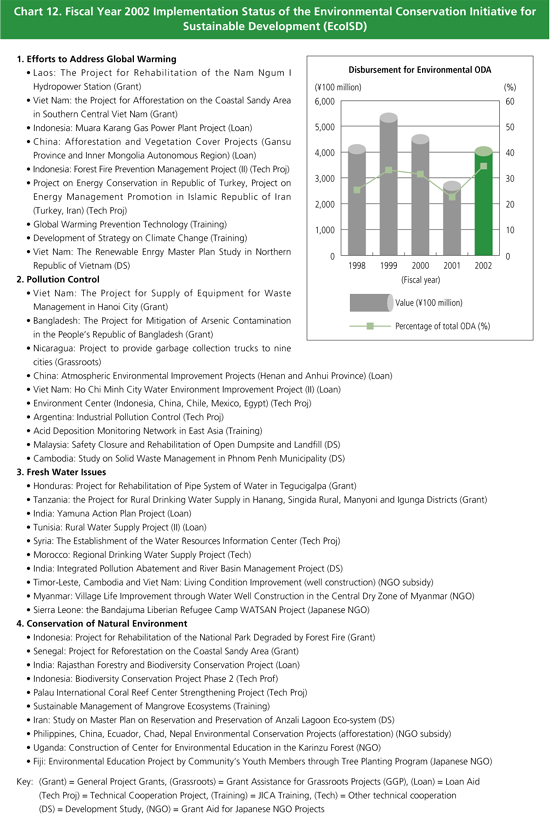 |
Japan is making efforts to combat infectious diseases in developing
countries through collaborations between MOFA, the Ministry of Health, Labour
and Welfare, JICA and other related ministries, agencies and organizations based
on the “Okinawa Infectious Diseases Initiative (IDI).” The IDI call
the due attention of the international community in measures to combat infectious
diseases and led to the establishment of the Global Fund to Fight AIDS, Tuberculosis
and Malaria in January 2002, as explained in Part II. (Refer
for details.) The specific efforts made in fiscal year 2002 for each major
infectious disease are as follows. Efforts in the health sector other than for
infectious diseases are explained in detail in Part III. (Refer
for details.)
A. HIV/AIDS
Japan is contributing to HIV/AIDS prevention activities for young people and
high risk groups, VCT activities (HIV/AIDS voluntary counseling and testing),
the development of AIDS testing and diagnostic kits, and other measures. Major
disbursements in fiscal year 2002 included: support for basic AIDS research
in Thailand, Kenya, Zambia and Ghana; the provision of HIV testing kits to 15
countries including Tanzania, Zambia, South Africa, Mexico, etc. And through
the Joint United Nations Programme on HIV/AIDS (UNAIDS), Japan has supported
to grasp the global trends in HIV/AIDS, developed vaccines, promoted the development
of new AIDS treatments, developed guidelines for AIDS control measures, and
taken other measures. (Refer for details about Japan’s
contributions to the Global Fund to Fight AIDS, Tuberculosis and Malaria, etc.)
B. Polio
Polio has nearly been eradicated from the entire world. For example, WHO declared
the Western Pacific region13 as a polio free area in 2000. Japan
provides assistance for the South Asian and African regions where polio has
not yet been eradicated, and in fiscal year 2002 it provided approximately ¥4.95
billion in assistance to 22 countries for polio vaccination and dispatched experts,
JOCV members.
C. Tuberculosis
In order to expand implementation of the DOTS (Directly Observed Therapy, Short
Course) strategy, in fiscal year 2002 Japan carried out cooperation including
provision of anti-TB drugs and testing equipment totaling ¥402 million to
China, dispatch of experts, acceptance of 44 trainees from developing countries
to Japan’s Research Institute of Tuberculosis, and construction of a tuberculosis
center in Yemen to conduct training about control measures, diagnosis and research
for tuberculosis.
D. Malaria
To combat malaria, Japan is mainly providing assistance for mosquito nets promotion.
Major disbursements in fiscal year 2002 included provision of mosquito nets
to Ethiopia and Mauritania, packaged with polio and measles vaccines, etc. as
a part of measures to combat childhood infectious diseases, and the provision
of mosquito nets and malaria prevention education in Nigeria.
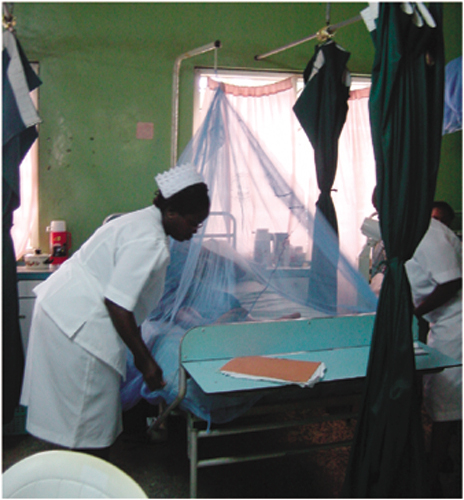 |
| A hospital using insecticide-treated mosquito nets to combat malaria (Nigeria) |
E. Parasitic Diseases
Japan is carrying out human resources development and research activities in
the International Parasite Control Centers it has established in Thailand, Kenya
and Ghana in order to control parasitic diseases, including malaria, and is
making efforts to combat guinea worm, filariasis, soil-born parasites, etc.
through support for NGOs and JOCV. In particular Japan is making the second
biggest contribution to eradication of the guinea worm after the US. The number
of people infected with the guinea worm worldwide declined from approximately
3.5 million in 1986 to approximately 55,000 in 2002, a 98% decrease. Japan is
continuing efforts toward eradication of the guinea worm from the entire world.
In February 2003 Japan hosted the “Workshop on Global Parasite Control
2003” and discussed the promotion of measures to combat parasites globally
with WHO, UNICEF, the World Bank, etc.
F. Severe Acute Respiratory Syndrome (SARS)
Concerning SARS control measures, Japan dispatched the Japan Disaster Relief
Expert Team14 to Viet Nam in March 2003. Japan received a request
for assistance to control SARS from the Government of Viet Nam on March 13 and
in collaboration with and coordination by the related ministries (Ministry of
Finance, Ministry of Health, Labour and Welfare, MOFA) and the implementing
agency (JICA), Japan was able to respond quickly, making the decision to send
the Expert Team on March 16. Japan had no experience of providing emergency
assistance to control emerging infectious diseases at that time and it was expected
that the Expert Team dispatched this time to help control SARS would face many
difficulties. However the Expert Team collaborated and coordinated with Bach
Mai Hospital in Hanoi, Viet Nam and organizations such as WHO, etc. that were
already implementing cooperation in Viet Nam through Japanese technical cooperation
projects, and it has been able to make a significant contribution to bringing
SARS under control in Viet Nam by giving advice about patient treatment approaches
and infection prevention, etc., providing infection prevention equipment, and
other efforts.
Japan is actively collaborating with international organizations such as UNICEF,
WHO, UNAIDS, etc. and with the US and other donor countries. In addition, measures
to control HIV/AIDS and other infectious diseases are being implemented through
funds established by contributions from Japan. These funds include the UN “Trust
Fund for Human Security;” the “Japan Trust Fund (JTF) for HIV/AIDS”
of the International Planned Parenthood Federation (IPPF), an international
NGO; the UNESCO “Japanese Funds-in-Trust for the Capacity-Building of Human
Resources;” the World Bank “Japan Social Development Fund” and
the UNDP “Japan Human Resources Trust Fund.”
As extensive cooperation, Japan has launched the “Japan-ASEAN Information
and Human Network for Infectious Diseases Control” for HIV/AIDS, tuberculosis,
and malaria and other parasitic diseases in the Asian region where Japan’s
experience fighting infectious diseases is easily applied and is promoting the
control of infectious diseases in the Asian region.
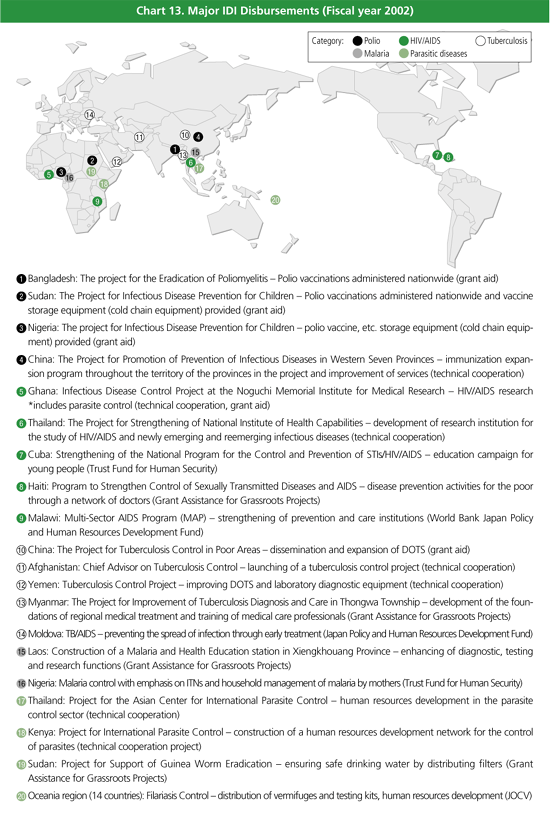 |
| Column 3 | Efforts to Control Neglected Diseases—the Pacific Program to Eliminate Lymphatic Filariasis (PacELF) | ||
|
Currently most international assistance to control infectious
diseases goes to fight HIV/AIDS, tuberculosis and malaria, etc. However,
HIV/AIDS, tuberculosis and malaria are not the only infectious diseases.
There are also diseases like filariasis that are not fatal, but cause
serious outcome to the human body and physical and psychological suffering
to patients. Diseases such as filariasis for which the development of
medicines is not advanced or there are medicines but these are not sufficiently
reaching the poor in developing countries are called “neglected
diseases.” These diseases were discussed at the G8 Evian Summit
in 2003 and measures to control them are urgently required.
*1 The symptoms that symbolize filariasis: the arms, legs and external genitals swell up like an elephant’s legs and the surface of the skin becomes very rough. The parasites that cause filariasis lodge in the lymph ducts inside the human body and grow there causing the lymph ducts to become blocked and lymph fluid to collect in the extremities, resulting in the above symptoms. |
|||
Participants in the World Food Summit held in 1996 announced that
they would cooperate in achieving global food security and halving the malnourished
population of the world by 2015 (The Rome Declaration). This target was also
incorporated in the MDGs compiled in 2000. At the “World Food Summit: Five
Years Later” held in June 2002, the specific targets of the Rome Declaration
were reaffirmed, the implementation of the Rome action plan was strengthened,
and a political document was adopted; the “international alliance to end
hunger” called for all stakeholders, including governments, international
organizations, civil society, the private sector, etc., to work toward achievement
of the target, etc.
| Column 4 | Malitubog-Maridagao Irrigation Project | ||
|
The Malitubog-Maridagao Irrigation Project was implemented
on the Mindanao Island, one of the poorest regions in the southern Philippines.
The objectives of the project were to construct irrigation facilities
in the central region of Mindanao Island, and to improve the agricultural
productivity of the region and improve the lives of the local farmers.
Japan provided ¥4.86 billion in ODA loans for the Government of
the Philippines in 1989.
|
|||
Japan, taking into account these efforts by the international community, is
mainly providing assistance that contributes to improving food productivity
in the agriculture, forestry and fisheries industries with the aim of achieving
sustainable food production. The majority of the poor in developing countries
live in rural areas and work in agriculture so assistance for the agricultural
sector is important not only for the food issue, but also for poverty reduction.
As for methods of providing cooperation, Japan believes that two approaches
are necessary: emergency measures and medium and long-term measures.
Emergency measures include responding to hunger, which remains a serious problem.
These measures are indispensable from a humanitarian perspective. At the WSSD
in August 2002, Japan announced food support for the food crisis in southern
Africa as one specific action of the Government of Japan for “sustainable
development” and aimed to respond appropriately to the needs in the region.
As a result, in fiscal year 2002 Japan provided food assistance of ¥10.13
billion for sub-Saharan Africa.
Medium and long-term measures are important from the perspective of eliminating
and preventing the causes of food problems including hunger and Japan is taking
various measures as follows.
In the agricultural sector Japan is providing funds to purchase fertilizer,
agricultural machinery, seeds for agricultural crops, etc. which are essential
for the cultivation of crops, carrying out technical cooperation such as acceptance
of trainees, dispatch of experts, dispatch of members of JOCV, etc. to improve
agricultural technology, for example by maintaining and managing irrigation
facilities and disseminating agriculture, providing cooperation for the development
of roads, collection points, etc. and the strengthening of distribution systems
in order to develop irrigation facilities and improve market access, and so
on. In introducing a typical project, Japan, with a view to utilizing the experience
of Asia in Africa in the agricultural sector, has dispatched experts to the
West African Rice Development Association (WARDA) to help with the development
of New Rice for Africa (NERICA), hybrid varieties developed through crossing
Asian and African rice species, and is providing assistance through international
organizations such as the UNDP and the Food and Agriculture Organization (FAO),
etc. The NERICA rice project is being implemented primarily in regions of West
Africa suitable for rice cultivation using methods that allow farmers to choose
from all rice varieties including NERICA, thereby enhancing farmers’ ownership.
Even though there are some differences among countries, it has been reported
that it can be expected that NERICA rice will become more widely grown in West
Africa. Meanwhile it has been reported that there are issues that need to be
improved including measures to deal with a shortage of seeds, managing soil
degradation, ensuring seed quality, developing appropriate cultivation standards,
identifying appropriate varieties for local environment, etc. Japan will continue
to make efforts to contribute to ensuring food security in the African region
by promoting research and development and dissemination of NERICA rice. Japan
is also providing active assistance to “Food for Work” projects and
to School Feedings being implemented by the World Food Programme (WFP). “Food
for Work” projects carry out development of rural infrastructure, etc.
through the participation by local farmers and pay them for their labor by distributing
food. Their objective is to promote the ownership of local residents. Providing
school meals increases children’s school attendance rates and their understanding
of lessons. In addition, distributing food as a take-home ration to children
at school, particularly girls, is useful for assisting the lives of families
and promoting understanding of education by families.
Concerning the provision of agricultural chemicals through the food production
assistance previously carried out by Japan, if such chemicals are not properly
stored there is a great danger that they will have a bad effect on the environment
and the human body so, beginning in December 2002 Japan decided in principle
not to provide agricultural chemicals unless sound storage institutions have
been put in place. Japan is making efforts for the appropriate implementation
of assistance by seeking the understanding and efforts for improvement of developing
countries.
In the fisheries sector, Japan is providing technical cooperation including
infrastructure development—for example development and provision of fishing
ports and fishing facilities, etc.—provision of equipment to the fisheries
vocational training centers and fisheries schools, technical assistance for
fishing, among other measures. Japan is also using Grant Assistance for Grassroots
Projects to provide assistance to improve the lives of subsistence fishermen
through regional fishing industry organizations.
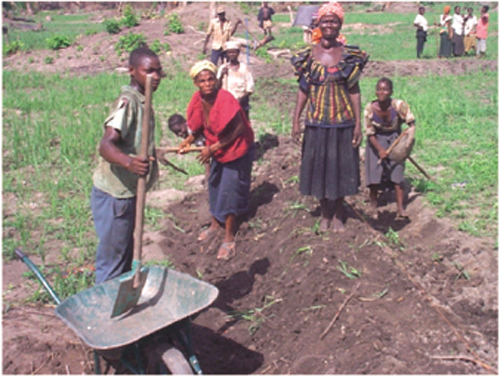 |
| Developing agricultural irrigation in a WFP Food for Work project (Côte d’Ivoire) |
In developing countries ensuring the stable energy supplies needed
to realize economic development is an issue. And it is forecasted that with
the economic development of mainly developing countries, particularly in Asia,
the world demand for energy will increase in the future. The energy problem
is a global issue that is related to measures to deal with global environmental
problem and achievement of sustainable development.
Japan, in light of the importance of energy from the perspective of sustainable
development and taking into account energy and environmental conservation, is
providing cooperation for a stable supply of energy in developing countries.
For Japan which is extremely dependent of imported energy and mineral resources,
cooperation in this sector is also important in terms of ensuring a stable supply
of resources. Japan is carrying out assistance for projects that are difficult
to implement through the private sector or Other Official Flows (OOF) and assistance
that contributes to the promotion of energy conservation or the promotion of
the use of renewable energy, etc.
In recent years, cooperation in this sector for projects designed to improve
public welfare and reduce poverty such as regional electrification and the development
of electricity transmission facilities have been increasing. Because they are
relatively large-scale and have substantial economic benefits, they have been
mostly implemented through ODA loans. In fiscal year 2002 ODA loans in the energy
sector came to approximately ¥221.5 billion (34.7% of all ODA loans) for
a total of 11 projects in seven countries and grant aid came to approximately
¥2.4 billion (2.4% of the total grant aid).
Among cooperation through ODA loans, the Tashkent Thermal Power Plant Modernization
Project in Uzbekistan, the Muara Karang Gas Power Plant Project and the Muara
Tawar Gas Fired Power Plant Extension Project in Indonesia, etc. also have the
objectives not only of providing a stable supply of electricity, but also of
reducing the environmental burden through efficient use of domestic natural
gas.
Concerning grant aid, in Nepal and Laos, Japan is providing designs for the
construction of new substations and the installation of power lines, and financial
cooperation for the repair of substations, etc. and is aiming for a stable electricity
supply. It is hoped that this will lead to the revitalization of socioeconomic
activity.
In the technical cooperation sector Japan is carrying out technology transfer
and human resources development in the energy and environmental measures sector—energy
management, energy conservation, renewable energy, and the development of industrialization—and
other sectors. For example, Japan is implementing factory analysis projects
including projects for on-site guidance in factories and the Energy Conservation
Training Center Project which carries out energy conservation training, etc.
In the future, Japan intends to advance energy sector cooperation that contributes
to the promotion of stable electricity supply in developing countries and promotion
of the CDM15 and that utilizes energy conservation and renewable
energy.
In recent years in the Asian region, particularly in the “Golden
Triangle,”16 the problem of synthetic drugs has worsened and
smuggling by international drugs syndicates has become more sophisticated. The
impact of such drugs problem on Japan is incalculable. Against this background
and from the perspective of the concept of “human security”—protecting
individuals from threats to their lives, livelihood, and dignity as well as
focusing on each individual in order to ensure the freedom and potential of
human beings—Japan is placing importance on tackling the drugs problem
in the international community.
It is important that both developed and developing countries make efforts to
control drugs as a matter of priority and take measures through international
cooperation involving related international organizations. Japan has made efforts
to strengthen cooperation with international organizations, in particular through
active involvement in drug-related international conferences17 and
financial contributions to the United Nations International Drug Control Program
(UNDCP), and to use bilateral ODA to support the drugs control efforts of developing
countries.
With regard to Japan’s assistance for drug control measures in fiscal year
2002 a large part of it went to the Indo-China region, and Latin America and
other regions are also major recipients. One characteristic of the assistance
implemented in fiscal year 2002 is that Japan’s projects widely benefited
the whole Indo-China region.
Cooperation to control drugs through Japan’s ODA has been effective by
implementation focusing on assistance in the reduction of drug demand and supply
and the improvement of crime prevention and law enforcement capacity.
Efforts to reduce demand include technical cooperation and such assistance as
drug-related education campaigns, and rehabilitation and vocational training
for addicts through activities carried out by international organizations and
NGOs.
Taking into account the fact that the background of the cultivation of poppies
and cannabis lies in the poverty of rural regions, Japan is placing priority,
in its efforts to reduce supply, on rural development in order to enable people
to earn a living without relying on drugs for income. Specifically, Japan is
providing assistance that directly improves the lives of residents in drugs
producing regions such as the development of irrigation facilities and support
for the cultivation of alternative crops.
Assistance for improvement of crime prevention and law enforcement capacity
is focused on transfer of drug analysis technology through technical cooperation
and human resources development such as assistance for the legislative development.
To give a specific example of assistance in fiscal year 2002, under the “Drug
Control Regional Cooperation Project (technical cooperation project 2002–2005)”
in Thailand, Japan is transferring the drug analysis technology, which is necessary
to identify major drugs manufacturing places to the Thai Office of the Narcotics
Control Board (ONCB). In this project, technology transfer is also being carried
out to the other countries in Indo-China (Viet Nam, Cambodia, Myanmar, Laos)
with Thailand as a base. The project is expected to widely benefit drugs control
measures in the Indo-China region in future.
13. The Western Pacific
region is 37 countries and regions including Japan, ROK, China, Viet Nam, Cambodia,
and Laos.
14. A total of six experts were dispatched:
three in the First Japan Disaster Relief Expert Team (March 16–25) and
three in the Second Japan Disaster Relief Expert Team (March 26 to April 1).
15. Refer to Environmental
Protection for details.
16. One of the largest opium and heroin producing
center in the world comprised of Thailand, Myanmar and Laos.
17. In April 2002 the “International
Drug Control Summit 2002” was jointly hosted by the Government of Japan,
the Federation of Japanese Parliamentarians to Fight Against Abuse of Narcotics
and Amphetamine-type Stimulants (ATS) (Japan) and the UNDCP. It was held in
Tokyo, marking the first time this summit was held in Asia.